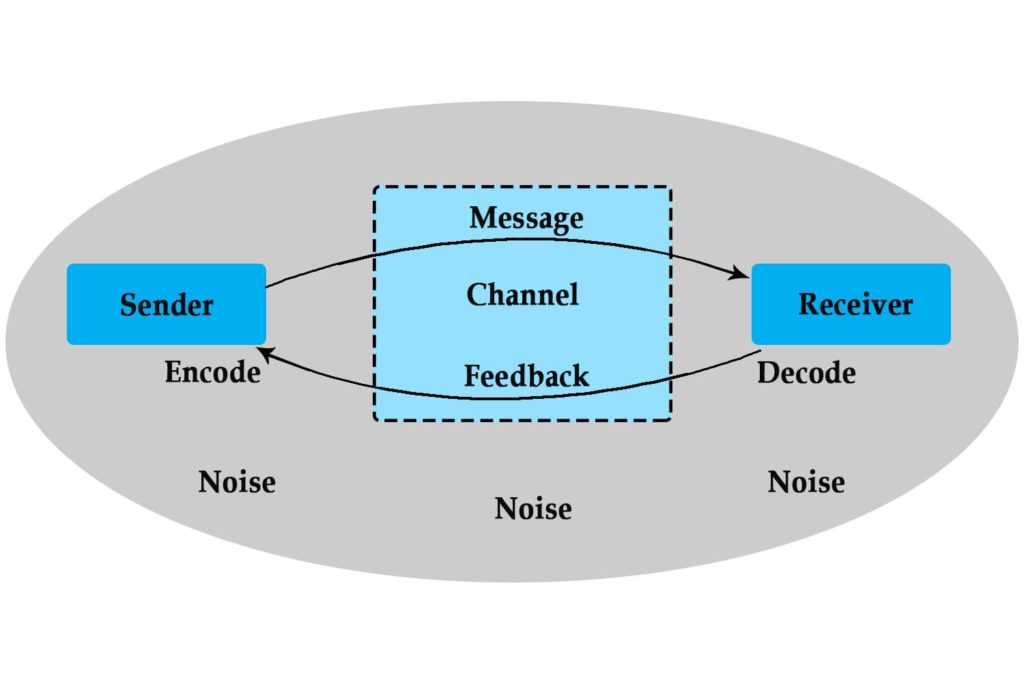Definition: A communication is a process where a message is delivered to two or more parties to create a shared understanding.
Communication is derived from the Latin word “Communis,” which means share.
Speaking with someone, sending a text, displaying emotions are all forms of communication.
The Communication Process

A simple communication process starts with the sender transmitting a message through a channel to a receiver. The receiver gets the message and provides the sender with feedback.
A communication process has seven elements:
- Sender
- Encoding
- Message
- Channel
- Receiver
- Decoding
- Feedback
Note that in some places, you can see five processes of communication: sender, transmission, noise, receiver, and feedback.
#1. Sender
The sender is the originator of the message. They are the ones with ideas or concepts that they wish to communicate with receivers. This is the beginning of the communication process. The sender plans the message and decides on the target audience.
#2. Encoding
Encoding is a process where the sender translates information into a message. Senders can use body language, text, audio calls, or video messages. The sender must translate the message in the correct form to be transmitted to the receivers.
#3. Message
The message is the information that the sender intends to deliver, and the receiver gets it after completing the encoding. A message can be in any form, such as a text, gesture, body language, audio message, direct communication, or a call.
#4. Channel
The channel is the medium that transmits the message to receivers. Choosing a communication channel depends on the message being sent, the urgency, and its requirements.
The sender must select the most appropriate channel to ensure the communication process is successful.
Direct and one-to-one communication is a better channel for formal communication, but electronic media can be a better option for open announcements.
#5. Receiver
A receiver is an intended recipient of the message. They are the one who receives the message and interpret it for further processing. The message can be received physically, electrically, visually, or any other form of reception.
#6. Decoding
For an effective communication process, the message must be decoded. Here, the receiver translates the message into an easy-to-understand form. Receiving a message in any foreign language would kill the communication if no decoding is available.
For proper communication, the sender and receiver must have the same understanding of the message.
#7. Feedback
Feedback is the last process of communication. It ensures that the receiver has received the message, decoded it, and understood it. Feedback helps improve communication processes.
Feedback provides the sender with a confirmation that the message has been received and the receiver has understood it correctly.
Barriers to the Communication Process
Noise is a barrier to the communication process. It can partly or fully affect communication and influence the message.
A sender should select a channel for the message with little or no noise. Noise can occur at any part of the process.
Noise can be:
- A faulty text or symbol in a letter
- Incorrect decoding
- Poor cell connection
- Poor call quality
- Wrong gesture
Tips for Efficient Communication
- Keep the message simple. A simple message is easy to transmit, decode, and understand.
- Choose the right channel to transmit your message.
- Understand your audience to draft a correct message and know when you should transmit it to them.
- Control your body language, tone, and word choice if you directly deliver a message.
- Always ask for feedback to ensure that a message is received.
- For orally delivered messages, maintain eye contact, and ask many questions.
Summary
A robust process of communication ensures the message is well delivered, received, and understood. Ensure that the message is well-drafted and the process has no noise for better communications.

Hi Parsadi.
I now understand what communication process is all about. Effective communication meets beyond bullying, i think we can add in a noise phone call cuts. This can be in a form of poor networking or personal decisive when sender is ready to delver his or her message. For example, someone had planned to deliver a message to friend,in a due cause a friend says let me call you back while you may be you have just started delivering your message to retain to what you started sometimes becomes transmitting the message causing communication breakdown.
But very impressive to learn all the nonverbal cues, the bullying happens in all social media platforms and the time that individual can spend to deliver his or her message to audience or receiver. Impressed to know such amazing barriers to communication processes such us language, tones, and many more.